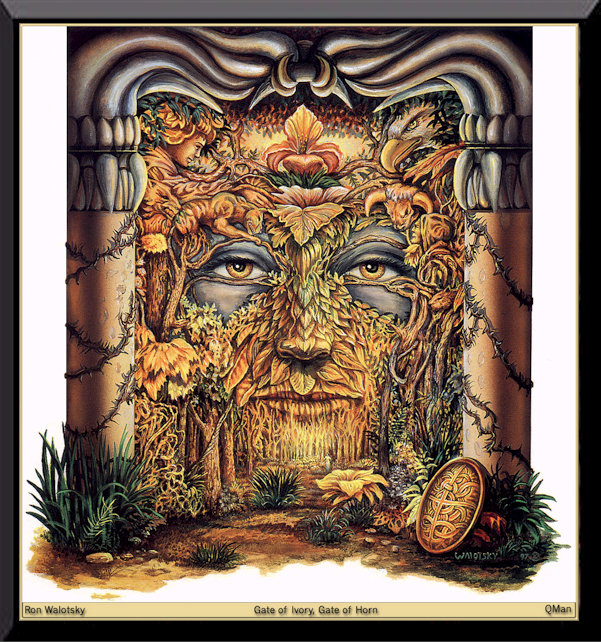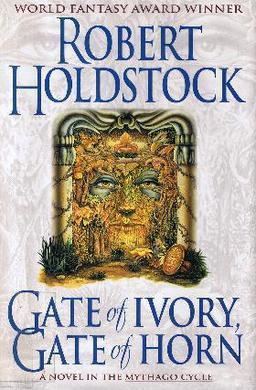 | ||
The gates of horn and ivory are a literary image used to distinguish true dreams (corresponding to factual occurrences) from false. The phrase originated in the Greek language, in which the word for "horn" is similar to that for "fulfil" and the word for "ivory" is similar to that for "deceive". On the basis of that play on words, true dreams are spoken of as coming through the gates of horn, false dreams as coming through those of ivory.
Contents
- Gates of Horn and Ivory
- The Odyssey
- Echoes in later Greek literature
- The Aeneid
- Other Latin writing
- English writing
- Music
- References

Gates of Horn and Ivory
The Odyssey

The earliest appearance of the image is in the Odyssey, book 19, lines 560-569. There Penelope, who has had a dream that seems to signify that her husband Odysseus is about to return, expresses by a play on words her conviction that the dream is false. She says:

Arthur T. Murray, translator of the original Loeb Classical Library edition of the Odyssey, commented:

Echoes in later Greek literature
Homer greatly influenced Greek literature as a whole. Plato refers to the two gates in his dialogue Charmides:
Socrates: "Listen then," I said, "to my dream, to see whether it comes through horn or through ivory."A reference to the Odyssean image also appears in the late (c. AD 400) epic poet Nonnus:
As Morrheus slept, the vision of a dream cajoled him,beguiling his mind after flitting through the gates of ivory.The Aeneid
Virgil borrowed the image of the two gates in lines 893-898 of Book 6 of his Aeneid, describing that of horn as the passageway for true shadows and that of ivory as that through which the Manes in the underworld send false dreams up to the living. Through the latter gate Virgil makes his hero Aeneas, accompanied by the Cumaean Sibyl, return from his visit to the underworld, where he has met, among others, his dead father Anchises:
Two gates the silent house of Sleep adorn;
Of polish'd ivory this, that of transparent horn:
True visions thro' transparent horn arise;
Thro' polish'd ivory pass deluding lies.
Of various things discoursing as he pass'd,
Anchises hither bends his steps at last.
Then, thro' the gate of iv'ry, he dismiss'd
Why Virgil has Aeneas return through the ivory gate (whence pass deluding lies) and not through that of horn is uncertain. One theory is that it refers to the time of night at which he returned. Jorge Luis Borges accepted the view that, for Virgil, what we call reality is not in fact such; that Virgil may have considered the Platonic world of the archetypes to be the real world.
Another explanation is that Virgil is thus indicating that what he has recounted is not to be taken as literal fact. In John Wesley's last sermon, preached on 17 January 1791, he spoke of how uncertain even the best conjectures about the invisible world were without revelation: "The most finished of all these accounts, is that of the great Roman poet. Where observe how warily he begins, with that apologetic preface, – Sit mihi fas audita loqui – 'May I be allowed to tell what I have heard'. And, in the conclusion, lest anyone should imagine he believed any of these accounts, he sends the relater of them out of hades by the ivory gate, through which, he had just informed us, that only dreams and shadows pass, – a very plain intimation, that all which has gone before, is to be looked upon as a dream!"
Other Latin writing
In his Silvae V iii 285-290, a lament for his dead father, the poet Publius Papinius Statius, expresses the wish that his father may come to him from the abode of the dead in the form of a true dream, passing therefore through the gate of horn:
Thence mayst thou pass to where the better gate of horn o'ercomes the envious ivory, and in the semblance of a dream teach me what thou wert wont to teach.
The 15th century Latin poet Basinio of Parma, employed at the court of Sigismondo Malatesta in Rimini, wrote a panegyric epic poem for his prince (Hesperis) modelled largely on the Aeneid and the Homeric epics, in which Sigismondo, as epic hero, undertakes a journey to the underworld in order to meet his deceased father Pandolfo Malatesta. Before that he passes the temple of Fama which has a bipartite gate, one half made of horn, one of ivory. On the ivory half not only Sigismondo's descent but also the ones by Hercules, Theseus, Ulysses and Aeneas are depicted.
"Having seen that, they turn towards the astounding temple of Fame, a temple enormous and imposing in size and shape, whose door on its left side is white from ivory steps with shining horn on the other half. Disturbing nightmares are conveyed by false rumour on the vain gates of ivory, while true dreams of horn are sent by trustworthy rumours. The gate of horn shows the Spaniards defeated on the Tyrrhenian shore [i.e. Sigismondo's victory over Alfonso's V. troops at Piombino in 1448]. On the ivory steps Sigismondo turns toward the sea, and is swimming after his ship is destroyed [on his way to the island where he is to undertake his trip to the underworld]. There Theseus and also Hercules made their way: there brave and victorious Ulysses went to the gloomy homes of the Cimmerians; there faithful Aeneas took to the Stygian lake Avernus."
Basinio's Latin text is as follows:
English writing
The gates of horn and ivory appear in the following notable English written works:
